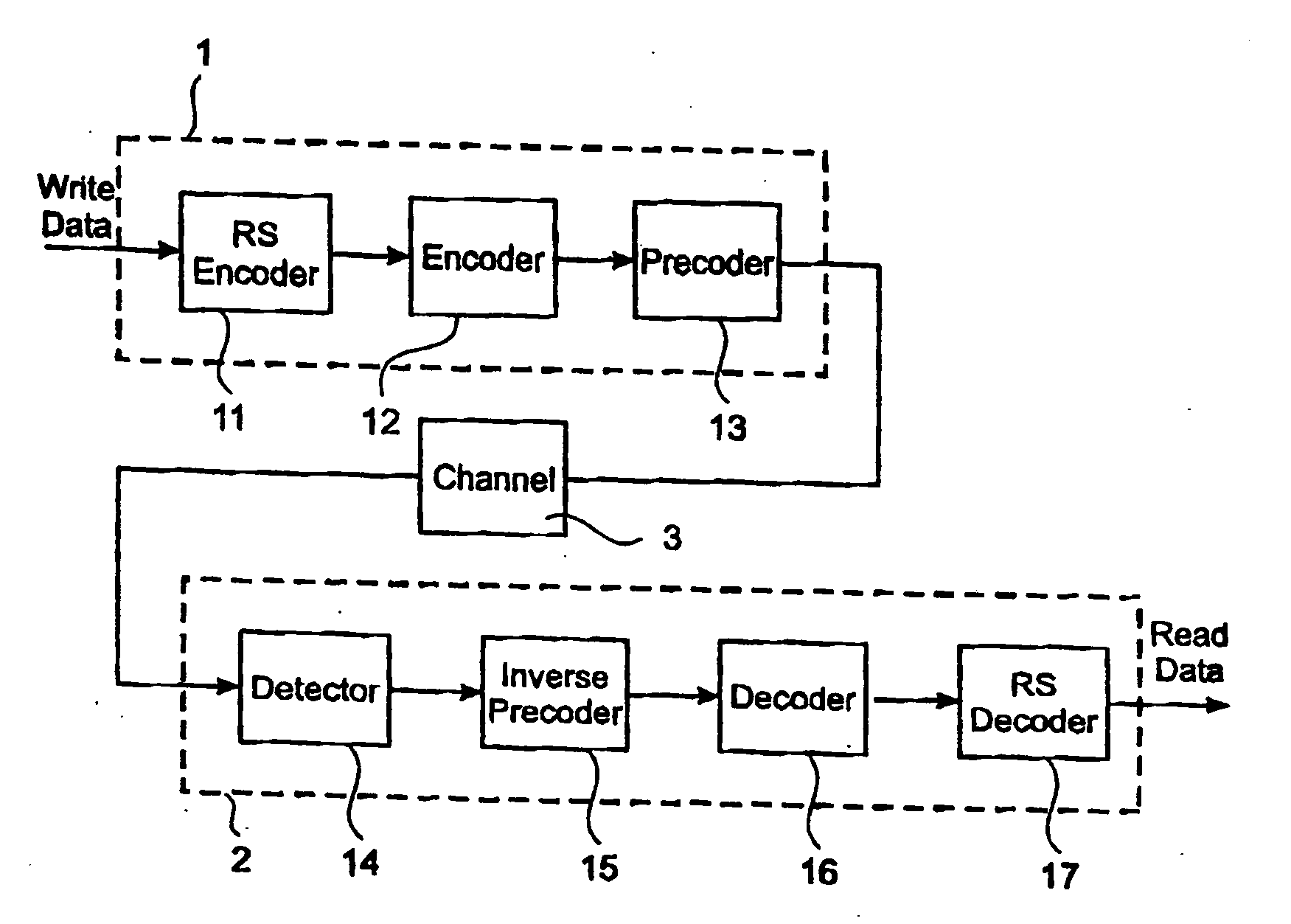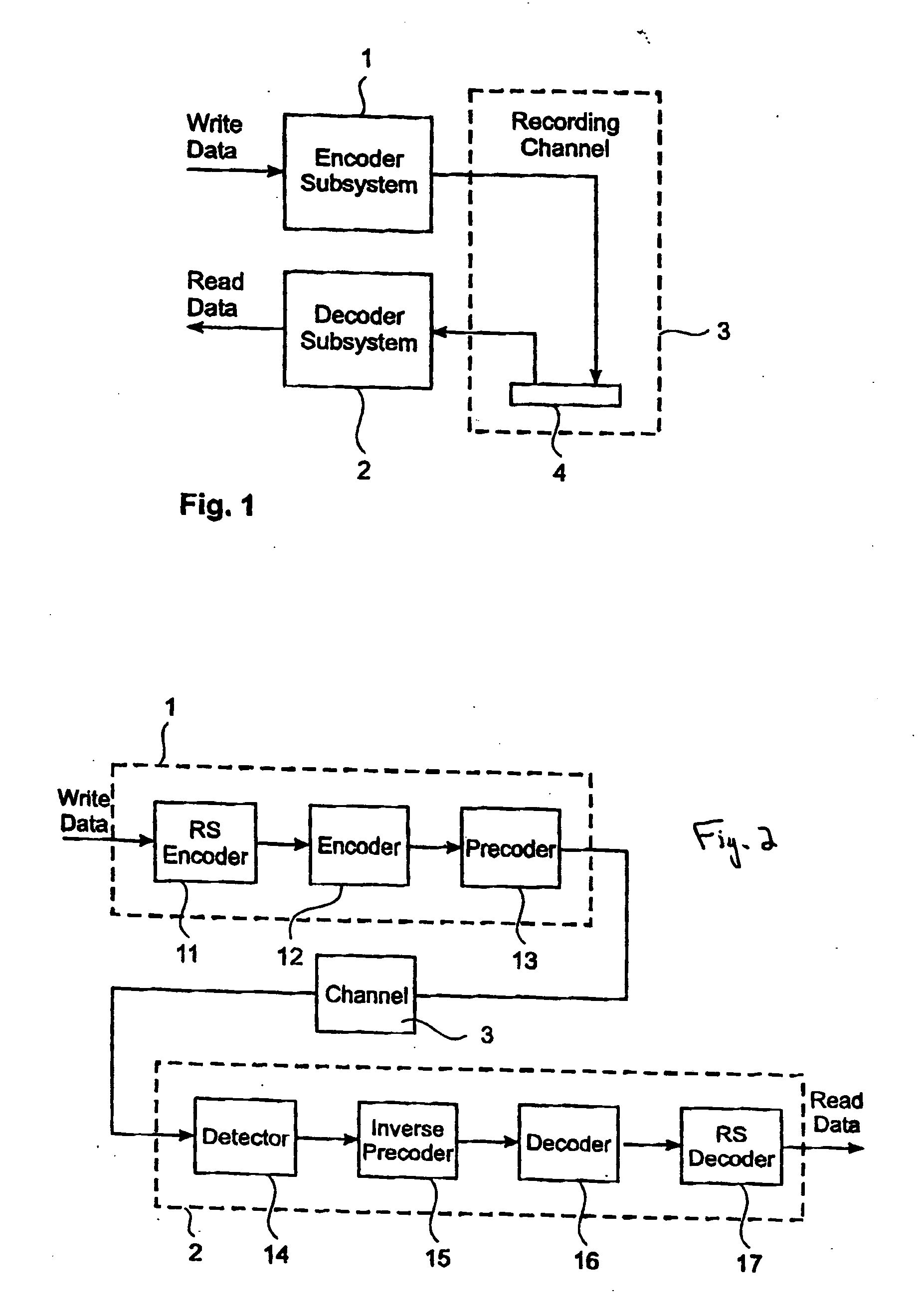[0015] The Applicants have recognized that it is possible to use precoding more selectively on a bit sequence to be encoded and that accordingly the use of precoding can be retained, but without the need to precode the entire input bit sequence. Thus, preceding can be applied to selected portions of the input bit sequence only. This reduces the amount of precoding that is applied (and accordingly the risk of error propagation due to the preceding), but does not eliminate the use of preceding altogether. Thus the present invention effectively uses selective or “local” preceding as compared to prior art systems that use precoding on all of the input stream (“global” preceding) or that use no preceding at all (are precoderless).
[0018] Thus, in a
system where
modulation coding is only applied to portions of the input bit sequence (i.e. such that after
modulation coding the bit sequence contains some modulation coded bits and some bits that have not been modulation coded (i.e. that pass through the modulation coding unchanged), for example, as described in U.S. Pat. Nos. 5,604,497 and 5,784,010, incorporated herein by reference in their entirety, the preceding is preferably applied only to the modulation coded bits but not to the uncoded bits. In other words, in a particularly preferred embodiment, the criteria that governs the application of the precoding is whether at the output of the modulation encoder a bit is encoded or not, with (most preferably), encoded bits being precoded, and uncoded bits (i.e. bits that are not changed by the modulation encoder) not being precoded. This avoids the need to perform inverse preceding on unmodulation coded bits when the data is read out, thereby reducing error propagation and improving error rate performance. Thus a preferred arrangement of the present invention is a precoder that is turned on and off depending on whether it operates on random data or modulation encoded data (within a given bit sequence or block, e.g. codeword).
[0027] An
advantage of distributing or permuting the modulation coded
data bits prior to precoding is that such distribution (e.g. permutation) has been found to further aid timing
recovery requirements, etc. Thus, for example, in an arrangement where only selected portions of the input bit sequence are modulation coded, in a particularly preferred embodiment of the present invention the modulation coded portions of the bit sequence are divided into plural (smaller) pieces, which pieces are then moved in position in the bit sequence so as to, e.g., space them apart and / or reorder them, i.e. such that the “pieces” of coded data are dispersed amongst the uncoded (unmodulation coded) bits also output after the modulation coding step. The preceding stage would then preferably selectively precode the modulation coded bits in the “permuted” bit sequence.
[0028] The Applicants have further recognized that moving (changing) the positions of the bits output after modulation encoding in the data sequence prior to precoding makes it possible (by appropriate selection of the bit
distribution pattern) to place, e.g., given parts of the modulation coded data sequence at particular, desired locations in the data sequence. In particular, for example, the modulation coded bits can effectively be placed at the same positions in the bit sequence as seen by the precoder, irrespective, e.g., of the
error correction coding and modulation coding scheme being used.
[0029] Thus, for example, by using an appropriate modulation coded bit distribution or permutation scheme, the same, unchanged, so-called “inner channel” (i.e. precoder, write / read stages,
detector, and inverse precoder) arrangement can be used with different outer,
error correction coding processes (i.e. such that the “inner channel” does not need to be changed to be able to operate with different outer, error correction coding processes). Thus, for example, where Reed-Solomon coding is used, the use of “permutation” as discussed above can allow the same “inner channel” (and modulation coding scheme) to be used for different Reed-Solomon code symbol sizes.
[0030] This is particularly advantageous, because although today outer Reed-Solomon error correction codes are usually based on 8-bit symbols, there is a move to the use of 10 bit Reed-Solomon symbols (as that offers a performance
gain of about 0.3 dB). It would be desirable therefore to provide a
system that can operate with either 8-bit or 10-bit Reed-Solomon codes. The present invention facilitates this by “permuting” the output of the modulation coding, which allows the same “inner channel” to be used with the two different Reed-Solomon symbol sizes.
 Login to View More
Login to View More  Login to View More
Login to View More 


